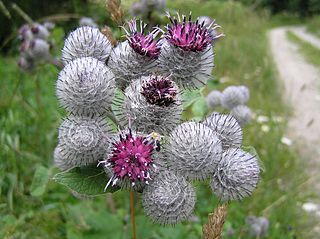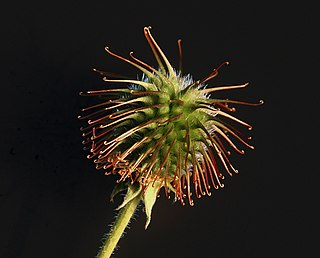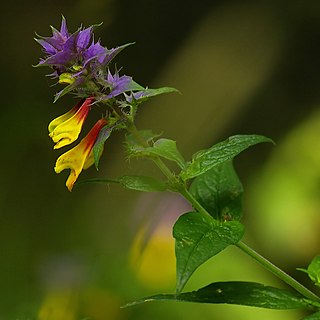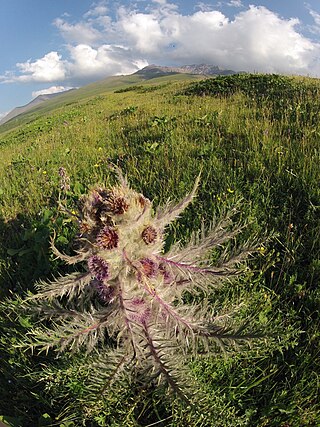
A biennial plant is a flowering plant that, generally in a temperate climate, takes two years to complete its biological life cycle.

Arctium is a genus of biennial plants commonly known as burdock, family Asteraceae. Native to Europe and Asia, several species have been widely introduced worldwide. Burdock's clinging properties, in addition to providing an excellent mechanism for seed dispersal, led to the invention of the hook and loop fastener.
Elephant ear may refer to:

Arctium lappa, commonly called greater burdock, gobō (牛蒡/ゴボウ), edible burdock, lappa, beggar's buttons, thorny burr, or happy major is a Eurasian species of plants in the family Asteraceae, cultivated in gardens for its root used as a vegetable. It has become an invasive weed of high-nitrogen soils in North America, Australia, and other regions.

A bur is a seed or dry fruit or infructescence that has hooks or teeth. The main function of the bur is to spread the seeds of the bur plant, often through epizoochory. The hooks of the bur are used to latch onto fur or fabric, enabling the bur – which contain seeds – to be transported to another location for dispersal. Another use for the spines and hooks are physical protection against herbivores. Their ability to stick to animals and fabrics has shaped their reputation as bothersome.
Burdock refers to Arctium, a genus of plants, particularly the species:

Xanthium strumarium is a species of annual plants of the family Asteraceae. Some sources claim it originates in southern Europe and Asia, but has been extensively naturalized elsewhere. Others, such as the Flora of China and Flora of North America, state it originates in the Americas but was an early introduction to Eurasia.

The Cardueae are a tribe of flowering plants in the daisy family (Asteraceae) and the subfamily Carduoideae. Most of them are commonly known as thistles; four of the best known genera are Carduus, Cynara, Cirsium, and Onopordum.

The genus Cousinia of the tribe Cardueae is in its current circumscription one of the larger genera in the Asteraceae, with approximately 650-700 species distributed in central and western Asia.

Arctium minus, commonly known as lesser burdock, little burdock, louse-bur, common burdock, button-bur, cuckoo-button, or wild rhubarb, is a biennial plant. This plant is native to Europe, but has become introduced elsewhere such as Australia, North and South America, and other places.

Melampyrum nemorosum is an herbaceous flowering plant in the family Orobanchaceae. It is native to Europe. In Sweden it is called natt och dag. In Russia it is called Ivan-da-Marya. a Christianisation of the traditional Slavic Kupalo-da-Mavka (Kupalo-and-Mavka).

Udea ferrugalis, the rusty dot pearl, is a moth of the family Crambidae. The species was first described by Jacob Hübner in 1796.

Arctium tomentosum, commonly known as the woolly burdock or downy burdock, is a species of burdock belonging to the family Asteraceae. The species was described by Philip Miller in 1768.

The frosted orange moth is a moth of the family Noctuidae which is found in Europe, Armenia, Syria and east through the Palearctic to western Siberia. It has also been recorded in Algeria. The species was first described by Michael Denis and Ignaz Schiffermüller in 1775. The frosted orange is a night-flying species with orange and brown speckled wings allow for perfect camouflage against autumn leaves in the daytime. It is attracted to light and does not come to flowers, and its larva inhabit the stems and roots of the species' food plants.

Lacanobia splendens, the splendid brocade, is a moth of the superfamily Noctuoidea. The species was first described by Jacob Hübner in 1808. It is found in temperate Europe and Asia up to the Pacific coast and Japan.

Aethes rubigana, the burdock conch, is a moth of the family Tortricidae. It was described by Treitschke in 1830. It is found in most of Europe, except the Iberian Peninsula and part of the Balkan Peninsula. Outside of Europe, it is found in China, Japan and Russia.

Metzneria lappella, the burdock seedhead moth or burdock seed moth, is a moth of the family Gelechiidae.
In botanical terminology, a phyllary, also known an involucral bract or tegule, is a single bract of the involucre of a composite flower. The involucre is the grouping of bracts together. Phyllaries are reduced leaf-like structures that form one or more whorls immediately below a flower head.

Arctium nidulans is a species of flowering plant in the family Asteraceae, native from Central Asia to north-west Xinjiang. It was first described by Eduard August von Regel in 1867 as Cirsium nidulans.
















